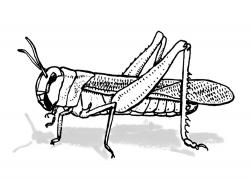They were the eighth plague visited upon Egypt: When Pharaoh refused to free the people of Israel, Exodus tells us, Moses stretched out his staff and a wind rose from the east, blowing hard for one day until a vast swarm of locusts arrived. So great was the size of the swarm that the land appeared black, and so voracious that in a matter of moments every tree and stalk was stripped bare of fruit and grain.
 Locusts have been a source of misery for farmers in dry places since the dawn of agriculture, responding to cycles of natural feast and famine and especially to changes in the weather. In a sense, they’re just grasshoppers with attitudes—or, rather, grasshoppers that have undergone hormonal transformations to become pesky monstrosities. The process works like this: In comparatively rainy years, grasshoppers distribute themselves broadly over the vegetation in arid and semiarid environments, carpeting fields of grass, say, visibly but not overwhelmingly, taking a little as they move along.
Locusts have been a source of misery for farmers in dry places since the dawn of agriculture, responding to cycles of natural feast and famine and especially to changes in the weather. In a sense, they’re just grasshoppers with attitudes—or, rather, grasshoppers that have undergone hormonal transformations to become pesky monstrosities. The process works like this: In comparatively rainy years, grasshoppers distribute themselves broadly over the vegetation in arid and semiarid environments, carpeting fields of grass, say, visibly but not overwhelmingly, taking a little as they move along.
When the rains cease and the vegetation shrivels, though, the grasshoppers crowd together to devour what they can, having sensed that food will soon be scarce. This crowding results in contact with other insects, producing a chemical change in them: Normally solitary, they become group animals instead, moving in swarms, eating anything they can.
 One of the largest locust swarms on record—in Ethiopia and Somalia in 1958—comprised approximately forty billion insects able to eat eighty thousand tons of food a day. Which raises a problem: Outbreaks of locusts are most severe, worldwide, in the belt stretching from where the Atlantic Ocean meets the Sahara Desert all the way across North Africa, through the Middle East, Afghanistan, and Iran on to Pakistan and India. These places are teeming with humans whose food supply is anything but secure. Grasshoppers breed in the wet monsoon season, and when the rain stops falling and ever-hotter weather brings stress to crops, environmental and biological conditions conspire to create a perfect storm for the new generation to become locusts and get to work. The 1958 swarm led to thousands of deaths due to starvation.
One of the largest locust swarms on record—in Ethiopia and Somalia in 1958—comprised approximately forty billion insects able to eat eighty thousand tons of food a day. Which raises a problem: Outbreaks of locusts are most severe, worldwide, in the belt stretching from where the Atlantic Ocean meets the Sahara Desert all the way across North Africa, through the Middle East, Afghanistan, and Iran on to Pakistan and India. These places are teeming with humans whose food supply is anything but secure. Grasshoppers breed in the wet monsoon season, and when the rain stops falling and ever-hotter weather brings stress to crops, environmental and biological conditions conspire to create a perfect storm for the new generation to become locusts and get to work. The 1958 swarm led to thousands of deaths due to starvation.
When grasshoppers turn into locusts, they are effectively unstoppable: There are simply not enough natural predators to inflict any great damage to their numbers, as Egyptians recently learned when a plague of locusts settled on Cairo, recalling those pharaonic calamities of old.
In the United States, the critters known as cicadas are often confused for locusts. They appear at about the same time, and sometimes in fearful numbers. Cicadas, though, are a different insect order, Hemiptera, versus the grasshoppers’ and locusts’ Orthoptera. Favoring wetter climes, they announce themselves with a raucous, rattling song. The loudest bunch of cicadas I ever heard occupied a grove of trees in Walt Disney’s childhood hometown of Marceline, Missouri. They didn’t give just a little whistle, but at least they didn’t strip the fields bare.






